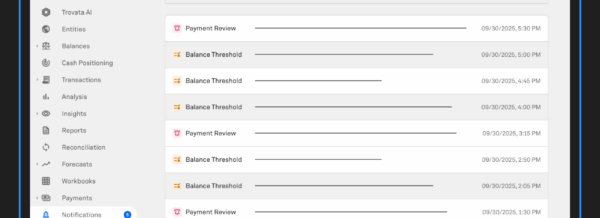The better an organization collects and analyzes its data, the better long term decisions senior executives and managers are likely to make. This is no secret, which is why a rudimentary overview of your data is no longer enough if you want to get ahead of the competition.
As a result Treasurers are constantly wondering how to improve treasury operations through streamlining data management and unlocking deeper insights. This is especially important given that a Blackline survey found that a whopping 98% of finance professionals stated they could be more confident in the visibility of their cash flow.
Bank APIs have emerged as a powerful solution in offering seamless, real-time access to richer transaction metadata that goes beyond basic account balances and transaction details. By leveraging bank APIs, businesses can unlock more information about their financial operations, gaining access to details such as merchant category codes, transaction descriptions, and even location data.
For treasurers, this level of data can revolutionize their role. It provides the ability to easily categorize expenses, track spending trends, identify potential cost-saving opportunities, and manage risk more effectively.
In this article, we’ll explore how to improve treasury operations by optimizing bank connectivity through APIs. The result? Your finance team will have access to richer transaction data, enhancing decision-making and helping to streamline operations.

How Does API Banking Work?
API banking is transforming how treasurers and finance professionals access and manage financial data. API banking allows banks to securely share their services and data with third-party platforms through Application Programming Interfaces (APIs).
Think of APIs as bridges that connect different software systems, allowing them to communicate and exchange information in real-time.
Traditional data transfer formats, such as BAI2, work on a file-based system. Imagine it like posting a letter, where the data is packaged at one end and then sent to the other. The receiver is limited to the data which is included in the package, and can only receive new data when another file is sent.
APIs work like a text messaging service such as iMessage, allowing data to be sent back and forth in real-time, with a connection that is always on. For treasury teams, this means seamless access to richer transaction data without having to log into multiple bank portals or rely on outdated manual processes.
“I gravitated to Trovata because of the APIs. The daily feed makes data readily available. Transaction tagging allows for easy categorization and a clear picture of cash flow. Logging in provides instant updates, eliminating the need for manual data pulls.”
Bruce Edlund – Assistant Treasurer at Cloud Software Group
Recommended: Learn how the treasury team at Cloud Software Group unlocked real-time visibility and scaled their capabilities with APIs.
The Benefits of Richer Metadata Through Bank APIs
One of the biggest advantages of using bank APIs is access to richer transaction metadata that goes far beyond basic details like amounts and dates. With bank APIs, treasurers can access a wide range of data points, including:
- Merchant category codes (MCC)
- Detailed transaction descriptions
- Location data and transaction timestamps
- Invoice numbers, payment references, and other identifiers

This enriched data allows treasurers and finance professionals to dig deeper into financial transactions, providing more meaningful insights.
A Metadata Example
Imagine you run a national chain of coffee shops. With traditional data connectivity methods on a legacy system such as a TMS, you’ll often simply see a list of transaction values and dates, making it difficult to draw meaningful conclusions, other than to track your overall revenue and expenses.
Instead, consider what happens when you access the same transaction list through an API. You can now see far more detail on each of those transactions, opening up huge opportunities for better management.
For example, you will be able to see the exact time of your transactions, which can help you better manage your staffing requirements throughout the day. Or, you can see the details on how your customers are paying for their coffees, giving you the opportunity to streamline your payment collections and seek better terms with payment services providers.
Treasurers can even review location data trends to ensure that liquidity is being managed appropriately across each store and region.
All of this additional information can be integrated into your Enterprise Resource Planning (ERP) software, linking this detailed metadata into the broader organizational data analysis and forecasting picture.
How Metadata Improves Analysis and Insights
There are other ways that enhanced metadata helps aid decision making.
Expense Categorization
Rich metadata helps treasurers automatically categorize expenses, saving time and reducing errors in financial reporting. This can speed up the monthly close process, and make it far quicker and easier to find specific transactions if required.
Spending Trend Analysis
Detailed transaction descriptions and merchant information make it easier to track spending patterns across different categories and regions. For instance, if a company notices rising costs for travel expenses in a specific region, they can take targeted action to manage these costs.
Fraud Detection
Access to transaction location data and more detailed descriptions can help identify unusual or suspicious transactions, enabling treasurers to detect potential fraud early. If you don’t have any operations in South America, but you start to see payments being made there, you can quickly spot the problem.
Optimizing Cash Flow
With richer metadata, treasurers can break down transaction data more effectively, providing clearer insights into spending trends and liquidity needs. This level of detail supports better cash flow forecasting and more strategic decision-making.
“(Before Trovata) It would typically take me an hour every day just to put together our standard daily cash report for our CFO. Drilldowns for detail were impossible, so any follow up questions he might have would mean another round of manual analysis. Any off-cycle reporting would then be additional hours of pouring over Excel workbooks.”
Faheem Sorathia – Senior Accountant at Emerald
Recommended: Discover how the treasury team at Emerald fully automated cash reporting and started saving 10 hours per week.
How to Implement Bank APIs Into Your Organization
To fully unlock the benefits of richer transaction data, treasurers and finance teams need to implement bank APIs effectively. Here are some steps to take:
1. Talk to your banks
Start by discussing API connectivity with your banks. Many banks offer a range of API services, but the availability and scope can vary. Understanding what APIs are offered — and what data they provide — will help you choose the right connections to meet your needs.
If they don’t all offer APIs, don’t worry. Modern treasury platforms like Trovata can still offer connectivity and data normalization for legacy file protocols, in conjunction with API integration.
2. Prioritize data security and privacy
While APIs offer incredible benefits, they must be implemented securely to protect sensitive financial data. Ensure that any API integrations adhere to your organization’s data privacy policies and industry security standards, such as encryption and secure authentication protocols.
3. Adopt a modern, API-first treasury platform
To maximize the potential of bank APIs, it’s essential to use an API-first treasury management platform. Trovata is an ideal solution.
Trovata pioneered the first bank API connection with JP Morgan and boasts the largest library of corporate banking APIs, connecting directly to 50+ enterprise banks and 2,000+ business banks. With Trovata, all your bank data is automatically normalized, categorized, and ready for real-time analysis, helping you manage your cash more efficiently and effectively.
Trovata’s platform is designed to make API connectivity seamless and secure, giving treasurers richer metadata that drives better insights into spending patterns, cash flow, and risk management.
Customizable tagging systems allow treasurers to align transaction data with general ledger account codes, streamlining reconciliation and reporting. The platform’s Google-like TQL search feature allows you to locate specific transactions in seconds, making data analysis quicker and more accessible.
How to Improve Treasury Operations with Trovata
By leveraging bank APIs through Trovata, treasurers can gain access to richer transaction data, enabling more accurate financial reporting, improved cash flow management, and enhanced decision-making.

The ability to tap into detailed transaction metadata gives treasurers the insights they need to optimize spending and strategically allocate resources.
These days, data accuracy and visibility are critical to business growth and security. Trovata’s API-first approach helps treasurers unlock the full potential of their transaction data, transforming their financial operations and positioning their teams for success.
“Implementing Trovata was very straight-forward. With the great support from Trovata’s client success team, we connected [Trovata] with our three major bank partners and the figures came in right as we were talking — it was instantaneous.”
Niall Burke – Global Treasury Manager at Eventbrite
Recommended: Learn how the treasury team at Eventbrite started saving 48 hours monthly and cut annual costs in half by fixing bank data quality with Trovata.
If you’re ready to enhance your treasury operations and tap into the power of richer transaction data, Trovata is the partner to get you there. Book a demo today!




